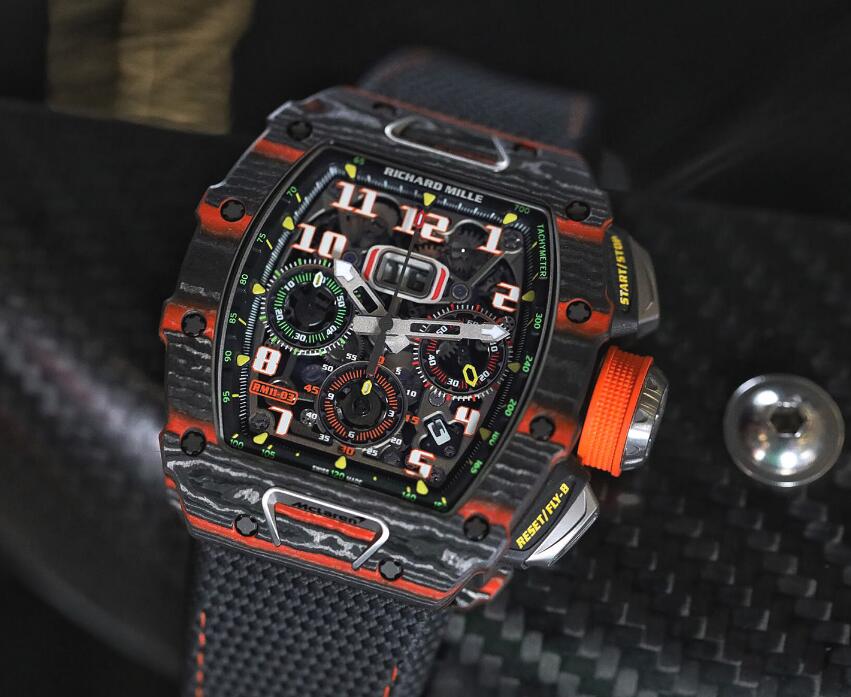
Richard Mille’s main trade inventory has never been ultra-thin watches – if anything, his timepieces over the years have been more striking in terms of depth, some downright gigantic. He can certainly make the watch thinner when he wants to, though, and it often works well. Both the rectangular RM 16 and the more recent RM 33-01 deviate from his usual habit, this year at SIHH he presents his latest RM 67-01, his flattest watch to date and the first he has made An extra-flat watch with a tonneau-shaped case, which has been the basis of his designs since the company launched its first watch in 2001.
Richard Mille’s trading stock has never been an ultra-thin watch – if anything, his timepieces have been more notable over the years for their depth play, and some are downright huge . He can certainly make the watch thinner when he wants to, though, and it often works well. Both the rectangular RM 16 and the more recent RM 33-01 deviate from his usual habit, this year at SIHH he presents his latest RM 67-01, his flattest watch to date and the first he has made An extra-flat watch with a tonneau-shaped case, which has been the basis of his designs since the company launched its first watch in 2001.
Richard Mille’s design work is hard to fault. Assuming you totally like this approach to watch design, there’s basically Richard Mille and those who try (often unsuccessfully) to imitate him. (Designing watches after Richard Mille is a bit like a painter after Jackson Pollock, or a writer after James Joyce; trying to replicate their success by replicating their language or visual vocabulary is both tempting and a bad idea idea.) The RM 67-01 is a great looking watch. The titanium version shown here does an excellent job of overall fit and finish; obviously each surface has been carefully considered in relation to the dial, gear train and other elements of the case, as we looked at Apple As the Watch said, attention to detail is true luxury.
Granted, Richard Mille has its own unique design language, but this celebration of the aesthetics of industrial materials is also a classic modernist design strategy, with a few other notable exceptions (such as the Royal Oak, which does have an important role in stainless steel in watches). , as Mies van der Rohe did in architecture) not many watch designers can do it like Richard Mille.
One of the interesting things about his approach is that, at least broadly speaking, it’s actually pretty conservative, which I think is a big part of Mille’s success. He’s very smart about challenging expectations, but offering the challenge in a reassuring framework so the whole thing doesn’t get too alienating.
Much of the appeal of his work lies in traditional watchmaking, both in finish and mechanics. boasting that you have a fast-spinning mainspring barrel and optimized gear tooth profiles, almost like a baseball, although Richard Mille’s watch has modern industrial materials and finishing methods, overall his aesthetic remains Relying on alternating, matt and brushed surfaces of polish, it has been the mainstay of Geneva watchmaking for hundreds of years.
Where I really struggle with Richard Mille copy is the pricing. Almost everyone you talk to these days will agree that things are getting out of hand, not just potential customers for the watch; quite a few CEOs or near CEO level have commented to us that they really want to know (I care about paraphrasing) this Has the industry not yet cornered itself. Where exactly does the disconnect between offered value and actual price start to become unacceptable? Of course, this depends on a lot of variables. Often, when we write about very expensive watches, we end up shrugging and saying “I believe that for its target customers, price doesn’t matter” or something like that. It’s also very easy to start thinking of price as an abstraction unrelated to watch design criticism. However, I think these two are really starting to feel like abdication of the responsibility to discuss important things. After all, sky-high prices in the art world are fair game to discuss how art is viewed; why not in watchmaking?
This is a titanium case chronograph watch with a date knob. Undoubtedly, high prices are part of the appeal to many Richard Mille clients – and it’s part of the reason his watches are such effective symbols of exclusivity, and if they weren’t so recognizable, they wouldn’t play that role well ( Also, it doesn’t hurt that they are often very attractive as design objects). I think it’s pretty clear that having a lot of talk about high cost and exclusivity about his watches is a deliberate strategy.
Regarding the RM 67-01, it’s obviously very expensive, but then again, watches from the likes of Kari Voutilainen and Roger Smith are similarly priced but offer very different The value proposition, perhaps the real disconnect for mechanical timepieces, at least at the high end, is not between value and price, but function and price. At this level, it is almost accidental that the object in question is a watch.
Update 2/11: Richard Mille clarified to us that the movement is designed in-house and manufactured externally; the company noted that it has always been transparent about its suppliers and will only refer to its movements as ” Made in-house”. An earlier version of this story failed to notice that the watch shown was a white gold model, not titanium. The story has been updated; we regret any confusion.
Richard Mille RM 67-01 Automatic Extra Flat; as shown, white gold case, 38.70mm x 47.52mm x 7.75mm. Hours, minutes, date; function indicator showing crown position. Movement, CRMA6 movement, 3.6 mm thick, designed by Richard Mille; platinum oscillating weight, 50-hour power reserve, 25 jewels at 28,800 vph. Water resistance, 50 m. The movement was designed by Richard Mille and manufactured externally.
